Let’s conclude our analysis, as already mentioned in the previous blog, by comparing the result of the tests on the Viro Made in Italy “Blocca catena” product with a 10 mm chain and its copies produced in the Far East. Once again, the results of the laboratory tests confirm the forecasts.
Let’s look at the test results.The first test was the resistance to corrosion caused by salt spray.
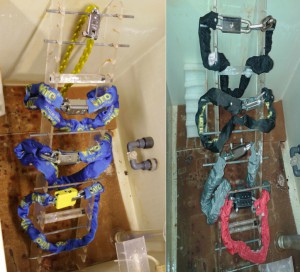
On the left, the original Viro products in the salt spray machine before testing and on the right the imitations.
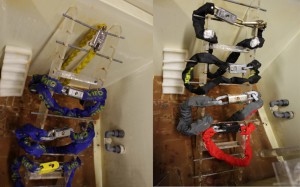
On the left, the original Viro products in the salt spray machine after testing and on the right the imitations.
Let’s focus or attention on the “Blocca catena” and its imitation.
As can be seen, there are a few signs of oxidation in the “Blocca catena” only at the drill-resistant plate of the lock, whilst the internal mechanism and the armour are free from corrosion.
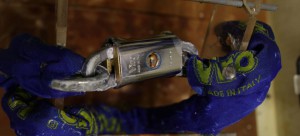
On the contrary, in the copy there are several areas strongly affected by corrosion, especially on the grips of the lock-bolts and on the armour.
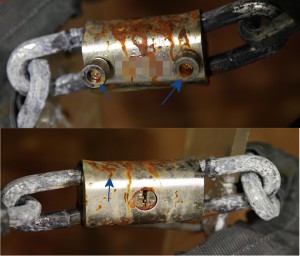
The most significant fact is, as can be seen in the short video below, that whilst the original Viro product still works perfectly after the salt spray test, the copy is blocked; it is extremely difficult to insert the key and it will not turn.
The second test we performed on our product and on the imitation is the attempt to cut the chain. We used a machine present in our test laboratory which, by using a mechanical arm, operates a hacksaw, and we tried to cut a Made in Italy chain link and then one of the chain of the imitation product.
As you can see in the video below, the chain of the Viro product withstands the cutting with the saw, as it is tempered and case-hardened.
On the contrary, the chain of the imitation product shows that it has been manufactured simply with iron which has not been heat treated, so it can be very easily cut with a hacksaw.
So let’s see the comparison of the 2 chains after the cutting test.
As mentioned previously, tempering and case-hardening are not sufficient conditions to be able to declare that the chain withstands any type of cutting. Indeed, cutters with long arms and rotary disks can be very risky for all types of chains.
Therefore, in addition to a correct positioning of the chain (to keep it as high off the ground as possible), the size of the cross section of the links, which withstand the action of these cutting tools, must also increase in relation to the value of the asset to be protected and the risky nature of the environment where the asset itself is stored.
Without doubt, chains made of simple iron which has not been heat treated do not offer any true protection.
However, tempering and case-hardening treatment of the steel help to make the chain more resistant to cutting, and therefore suitable for use with padlocks to guard two-wheeled vehicles.
The third test we performed concerns the resistance of the padlocks themselves, that is, of the Viro “Blocca catena” for 10 mm chains and the imitation product.
As in this case the copy has an inner body made of brass just like the original Viro product (not zamak like other imitations analysed so far), we have not subjected the 2 padlocks to the test with blows on the body, as we did in the previous cases; we focussed instead of a clear difference highlighted in the previous blog, that is, the different construction of the lock-bolts.
Thieves generally attack the weakest point of a protection system and, as mentioned several times in previous blogs, each security product is only as effective as the strength of its “weakest link”.
In this case, when talking about padlocks with chains, another “weak link” is identified in the lock-bolts of the imitation padlock right after the chain cutting test.
Again within the testing laboratory, we have blocked the lock-bolt of the products in a vice and then inserted the products in a device which reproduces the blows delivered from a height of 1 m, from the top downwards, with a weight of 7.15 kg, thereby obtaining the same effect for each blow as an intense traction which tends to pull the lock-bolt from the padlocks.
It can be seen that when the “Blocca catena” is subjected to 2 blows it remains closed and the result achieved is the detachment of the head of the lock-bolt, which is especially designed for programmed breakage, so that when trying to pull them from the body of the padlock they break at a specific predetermined point, leaving the padlock closed and the remaining part of the lock-bolt inside the body, which can therefore no longer be gripped.
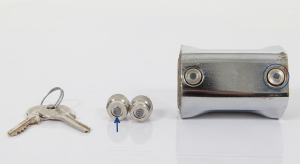
However, it can be seen how, in the imitation product, the first blow immediately detaches the lock-bolt from the attachment point in the body (we purposely slowed down the video and used a still image to clearly highlight the detachment of the lock-bolt from its anchor point) and, after the second blow, one lock-bolt can be slid out completely whilst the other lock-bolt is clearly bent.
This means that the lock-bolts of the imitation product were not designed to effectively withstand pull-out attempts.
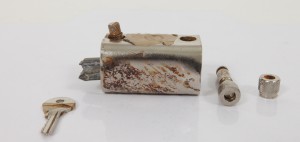
At the end of this test, the result is truly shocking for the imitation, compared with the original Viro product.
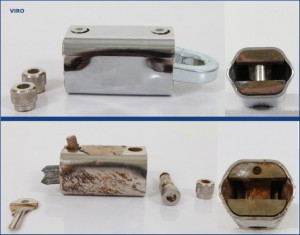
Summing up after this last analysis, we can confirm that after checking the materials and, even more so, after the strength tests, the imitations of the “Blocca catena” with 10 mm chains cannot be compared with the original product.
In effect, these copies are made with the aim of tricking users, by means of the very similar appearance, who are seeking adequate protection for their bikes, but they do not offer any real defence.
One padlock is not worth the same as another, Viro is worth more!
Beware of imitations.
Look at the data sheet of the “Blocca catena” padlock with chain
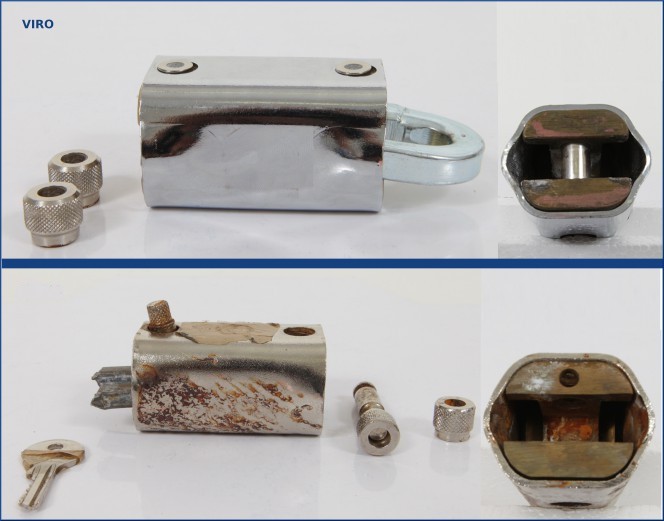
I like the report